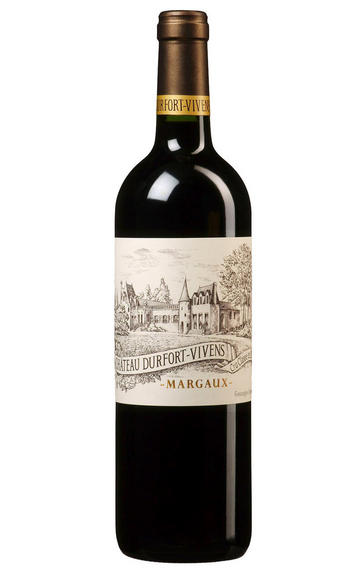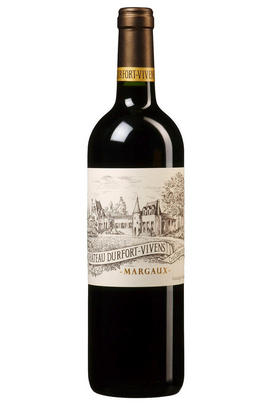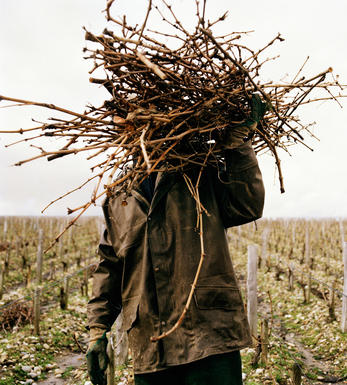
2010 Château Durfort-Vivens, Margaux, Bordeaux

Critics reviews
Robert M. Parker, Jr. - 28/02/2013
(Jancis Robinson MW- jancis robinson.com Apr 2011)
(James Molesworth – The Wine Spectator – Apr 2011)
(Robert Parker- Wine Advocate- May 2011)
About this WINE

Chateau Durfort-Vivens
Château Durfort-Vivens has been owned by the Lurton family since 1961 when Lucien Lurton purchased it from the Gineset family. For many years this 2ème Cru Classé Margaux property was perceived as underachieving - however, the estate has undergone a mini-renaissance since Lucien`s son Gonzague took over at the helm.
Durfort-Vivens's vineyards(Cabernet Sauvignon 65%, Merlot 20%, Cabernet Franc 15%) lie on gravelly soils interspersed with limestone. Vinification includes approximately 18 months' wood ageing, 30-50% new oak.
The proportion of Cabernet Sauvignon in the final blend (82%) is the highest of any wine in the southern Médoc and gives the wine classic blackcurrant and cassis characteristics as well as notable tannins and structure. Durfort-Vivens may be approached after 5 years or so in bottle but will continue improving for up to 10 years.

Margaux
If Pauillac can be seen as the bastion of ‘traditional’ Red Bordeaux, then Margaux represents its other facet in producing wines that are among Bordeaux’s most sensual and alluring. It is the largest commune in the Médoc, encompassing the communes of Cantenac, Soussans, Arsac and Labaude, in addition to Margaux itself. Located in the centre of the Haut-Médoc, Margaux is the closest of the important communes to the city of Bordeaux.
The soils in Margaux are the lightest and most gravelly of the Médoc, with some also containing a high percentage of sand. Vineyards located in Cantenac and Margaux make up the core of the appelation with the best vineyard sites being located on well-drained slopes, whose lighter soils give Margaux its deft touch and silky perfumes. Further away from the water, there is a greater clay content and the wines are less dramatically perfumed.
Margaux is the most diffuse of all the Médoc appelations with a reputation for scaling the heights with irreproachable wines such as Ch. Margaux and Ch. Palmer, but also plumbing the depths, with too many other châteaux not fulfilling their potential. There has been an upward shift in recent years, but the appellation cannot yet boast the reliability of St Julien. However, the finest Margaux are exquisitely perfumed and models of refinement and subtlety which have few parallels in Bordeaux.
Recommended Châteaux: Ch. Margaux, Ch. Palmer, Ch. Brane-Cantenac, Ch. Rauzan-Ségla , Ch. Dufort-Vivens, Ch. Ferrière, Ch. du Tertre, Ch. Giscours, Ch. d'Angludet.

Cabernet Sauvignon Blend
Cabernet Sauvignon lends itself particularly well in blends with Merlot. This is actually the archetypal Bordeaux blend, though in different proportions in the sub-regions and sometimes topped up with Cabernet Franc, Malbec, and Petit Verdot.
In the Médoc and Graves the percentage of Cabernet Sauvignon in the blend can range from 95% (Mouton-Rothschild) to as low as 40%. It is particularly suited to the dry, warm, free- draining, gravel-rich soils and is responsible for the redolent cassis characteristics as well as the depth of colour, tannic structure and pronounced acidity of Médoc wines. However 100% Cabernet Sauvignon wines can be slightly hollow-tasting in the middle palate and Merlot with its generous, fleshy fruit flavours acts as a perfect foil by filling in this cavity.
In St-Emilion and Pomerol, the blends are Merlot dominated as Cabernet Sauvignon can struggle to ripen there - when it is included, it adds structure and body to the wine. Sassicaia is the most famous Bordeaux blend in Italy and has spawned many imitations, whereby the blend is now firmly established in the New World and particularly in California and Australia.


Buying options
Add to wishlist
Description
We have been waiting for this for years and there were smiles all round; finally we have a Durfort Vivens wine which excites. A complete contrast to recent years, its rich, velvety, warm fruit provides real class and elegance. This is finely structured and, like many wines of Margaux, it is an absolute joy. Perhaps this offering is worthy of its Second Growth status, and it is sure to be one of the value wines of the vintage.
(Jake Dean BBR Fine Wine)
wine at a glance
Delivery and quality guarantee